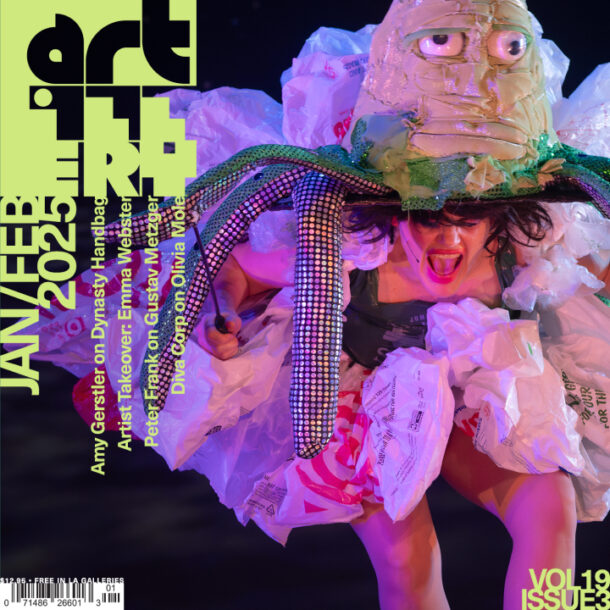
Alex Stern’s bold, vertical abstractions in “Golden Sunshine,” his first solo show at Pio Pico, are embedded with wry, obliquely self-referential allusions to his painting process, meditation practice, and inner life.
Reflecting his bicoastal sensibilities as a Northeastern transplant residing in Los Angeles, Stern’s ironic humor and use of text invokes West Coast artists like Ed Ruscha, a significant early influence; while his geometric, perpendicular layouts recall postwar painters from New York, such as Frank Stella and Brice Marden. Yet Stern’s surfaces and facture are singular. He approaches his paintings as objects, intuitively building up glazes of oil color over gold and silver leaf, found images, and fabric strips in a process he likens to constructing a house. Even the edges wrapped around the stretcher bars are carefully considered, and seem to seal the interior of his paintings. Viewed closely, each surface’s handmade nature is evident in slightly shaky lines and irregularities of brushwork, texture, and metallic appliqués glimmering through transparent jewel hues. From afar, the compositions coalesce into words and acquire depth, echoing the sway and materiality of skyscrapers and other staples of metropolitan environs. Having spent his early life in Boston and New York, the artist states that his towering compositions and plurality of media are partly inspired by what it feels like to be in a city of glass, steel, and concrete.
The phrase Golden Sunshine conjures up dreamy, lustrous visions; but Stern’s canvas bearing that name, writ large across its confines, is anything but resplendent. On the contrary, not a speck of gilt can be discovered within its tenebrous palette of ebony, indigo, and olive green. In fact, the word “Sunshine” occupying the lower portion of the monumental composition can barely be read at all among the dismal longitudinal bands breaking up the text. Given the noun’s suggested brightness, its illegibility seems counterintuitive, but somehow it fits: Sunrays illuminate, but they also can blind—look too long, and you’ll see darkness. Stern lifted the titular catchphrase from David Lynch’s KCRW weather reports. The painting is an homage to LA, encapsulating his ambivalence toward the city he has intermittently called home for the past 12 years. Countering stereotypically positive associations, it instead evokes noirish urban realities of endless asphalt, shady tunnels, and dingy freeway underpasses occupied by people unhoused. As with much of Stern’s work, what initially appears a humorous disjunction paradoxically loops back into something that makes perfect sense.
The deadpan continues in Flowers Bloom, where wavy hallucinogenic arrangements of nostalgically candy-colored stripes punctuate the phrase, “IN THE HIGH MEADOWS AND ON THE SLOPES,” lifted from a guided meditation by Jon Kabat-Zinn, a guru instrumental to the artist’s life. It’s easy to read double entendre related to drug usage into the word “high,” especially given the fact that Stern’s previous bodies of work addressed addiction and the opioid crisis.
His personal mantra appears in Focus, where the titular word, its “o” shaped like a heart, materializes between two interlaced cascades of stripes. The artist describes the variegated text as a meditation in real time as he painted it, as well as an entreaty to the viewer to be fully present in the experience of looking. With their quirky abstract arrangements, eccentric interspersions of text, and quasi-confessional content, Stern’s paintings are punctuated by an intriguingly awkward, uncertain intermediateness. Answer veritably shouts its text at the viewer—Is it a command or rejoinder? Should a painting ask questions, or provide an answer? Perhaps the answer is in the question in the painting, which indeed does a little of both.
—Annabel Osberg

